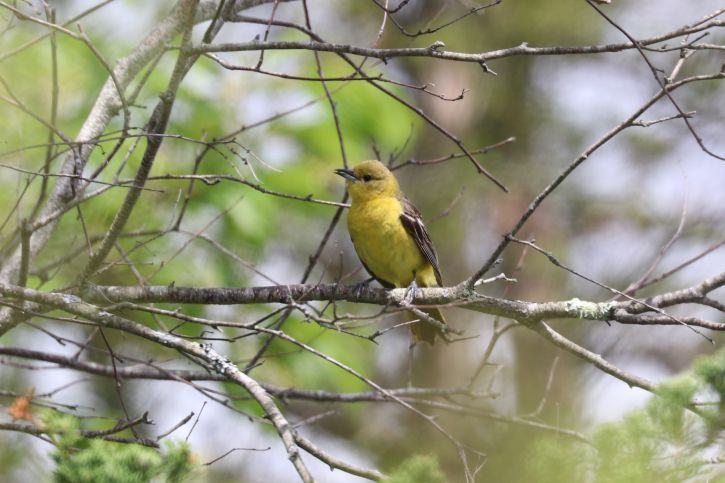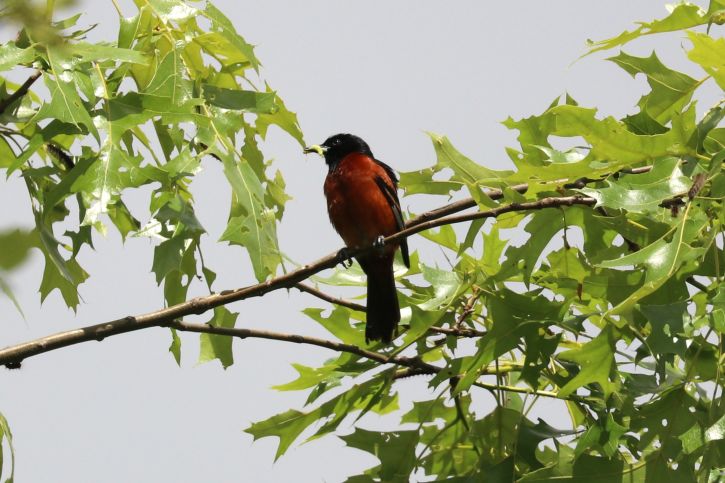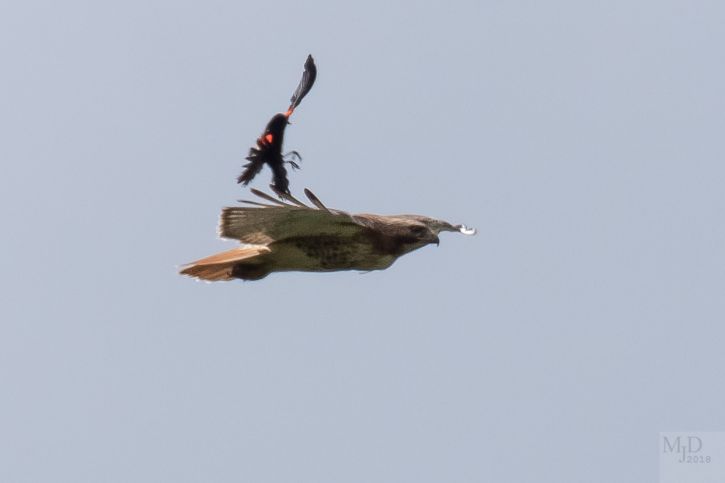Anticipating the first week of post-migration birding,for Wednesday Morning Birding this week, Dave Williams and I decided to take the group on a “swamp tour” inland of Joppa Flats. We left for Pikes Bridge Road, where we began hearing territorial songs the minute we opened the doors of the vans. Across Turkey Hill Road, a coulpe of Blue-winged Warblers begged for brew in buzzy tones, “Beeer, pleeeeeezz.” A couple of Willow Flycatchers stuck to the texbook “Fitz-bew.” Blue-gray Gnatcatchers called in the white oaks along the road. We don’t have much of a mnemonic for them, unless you are okay with “eeeeee, eee eeeeeee.” Sibley uses a lot more letters, so I will have to listen a bit more closely.
On Pike’s Bridge Road, we found a Black-and-white Warbler, a pair of Common Yellowthroats, more gnatcatchers, Black-capped Chickadees, and Gray Catbirds, all of which were reacting to a brief recording we played of chickadees mobbing a screech-owl. We discussed how this technique is used in citizen science programs that focus on declining species, and how important it is to not abuse the use of such materials. A Wood Thrush and an Ovenbird sang in the distance.
A “quiz bird” we had looked at in the lobby at Joppa Flats before we’d left appeared when we arrived at the bridge. First we saw her nest nearby; then her mate flew in. They both visited the nest, indicating that there are already young being fed. Rather than gulping his meal, the male held on to it for either his young or his mate, showing us how to be a good parent. See this handsome pair below.

Orchard Oriole female – John Lynn

Orchard Oriole with worm – John Lynn
We discovered an extravaganza of nests on that trail, and watched the breeding activity of Eastern Kingbirds, Warbling Vireos, and Baltimore Orioles.

Eastern Kingbird on nest – Mike Densmore

Warbling Vireo nest- John Lynn
A couple of Red-tailed Hawks were also out foraging, and dealing with the inevitable irritations of living near wetlands as they passed by. Mike Densmore has developed quite the penchant for action shots!

Red-winged Blackbird harasses Red-tailed Hawk – Mike Densmore
Our next swamp stop was on Ash Street, where we hoped to find one species in particular, and find it we did, as you see below. The swamp was rather quiet, with fewer Swamp Sparrows singing than are really there, we think. Since we didn’t see any Wood Ducks, we can assume that they’re sitting on eggs. We heard other species’ songs in the background, including an Eastern Phoebe, an Indigo Bunting, and a female Wild Turkey’s cluck or two.

Yellow-throated Vireo – Bob Minton
The lovely weather and pleasant pursuit of observing the activities of breeding birds had slowed us down a bit, so we didn’t have lots of time at swamp stop number three, Crane Neck Road. Along with birds already noted here, we enjoyed the early summer sound of an Eastern Wood Pewee, which puts one in a mood to lie in a hammock. That is true especially if you have ever taught in a classroom, when the beautiful sound of the pewee means that school is either out, or soon will be. It evokes a delicious sense of freedom and possibility, which fills you as the pewee’s song wends its way through a newly leafy wood, and lands deep in your heart.
Our List:
Canada Goose (2) – in a murky pond on Crane Neck Rd.
Wild Turkey (2) – Seen and heard various.
Great Blue Heron – Crane Neck Wildlife Management Area.
Glossy Ibis (~10) – seen at Common Pasture (Scotland Road)by the last car in the line, but not reported until later(!).
Red-tailed Hawk (2) – Ash Street Swamp.
Chimney Swift (3) – Pikes Bridge Rd.
Downy Woodpecker (3) – various.
Northern Flicker (1) – Hanover Street, on the sidewalk foraging for worms.
Eastern Wood-Pewee(1) – Crane Neck Wildlife Management Area.
Willow Flycatcher (2) – Turkey Hill Rd.
Eastern Phoebe – Ash Street Swamp.
Great Crested Flycatcher (3) – various.
Eastern Kingbird (2) – Pikes Bridge Rd.
Yellow-throated Vireo (1) – Ash Street Swamp.
Warbling Vireo (5) – various.
Red-eyed Vireo (1) – Pikes Bridge Rd.
Blue Jay (1) – Pikes Bridge Rd.
American Crow (1) – roadside.
Fish Crow (1) -Pikes Bridge Rd.
Tree Swallow – common.
Black-capped Chickadee (2) – Pikes Bridge Rd
Tufted Titmouse (1) – Ash Street Swamp.
House Wren (1) – Brickett Rd.
Marsh Wren (1) – Ash Street Swamp.
Blue-gray Gnatcatcher (4) – Pikes Bridge Rd.
Wood Thrush (1) – Pikes Bridge Rd.
American Robin (2) – Pikes Bridge Rd.
Gray Catbird – common.
Northern Mockingbird (1) – Pikes Bridge Rd.
European Starling – yes.
Cedar Waxwing (3) – Pikes Bridge Rd.
House Sparrow – yes.
American Goldfinch (2) – Ash Street Swamp.
Ovenbird (1) – Pikes Bridge Rd.
Blue-winged Warbler (2) – Pikes Bridge Rd.
Black-and-white Warbler (1) – Pikes Bridge Rd.
Common Yellowthroat – common
American Redstart (2) – Crane Neck Rd.
Yellow Warbler – common.
Eastern Towhee (1) – Pikes Bridge Rd.
Chipping Sparrow (1) Crane Neck Rd.
Song Sparrow (2) – Pikes Bridge Rd.
Swamp Sparrow (3+) – Ash Street Swamp.
Scarlet Tanager (1) – Ash Street Swamp.
Northern Cardinal (1) – Pikes Bridge Rd.
Indigo Bunting (1) – Ash Street Swamp.
Red-winged Blackbird – common.
Common Grackle – common.
Brown-headed Cowbird (1) – Middle Rd.
Orchard Oriole (3) – 1, Joppa Flats parking lot; 2, Pikes Bridge Rd.
Baltimore Oriole (3) – 2, Pikes Bridge Rd; 1, Ash Street Swamp.
From the June 2018 Birding Community E-bulletin (adapted a bit, and edited for length):
TIP OF THE MONTH: BACK OFF
At this season, as many birds are nest-building, incubating, or feeding young, they are extremely vulnerable. And there are no good reasons why we should make their lives any more vulnerable or more difficult. Too close an approach to a nest can lead to severe consequences. And reoccurring visits in particular, can leave a path or a scent trail for potential predators to follow. If you find a nest, don’t simply go back the way you came, leaving a dead-end trail to the location; try to leave the area by another route.
Basically, if you come across a nest, and unless you’re doing real research, it’s time to move on. Don’t linger, don’t return, and don’t tell others how to find the nest. This season is a stressful time for birds, and usually they will let you know when you are getting too close. We should pay close attention, and let birds drive us away if they are of a mind to.

